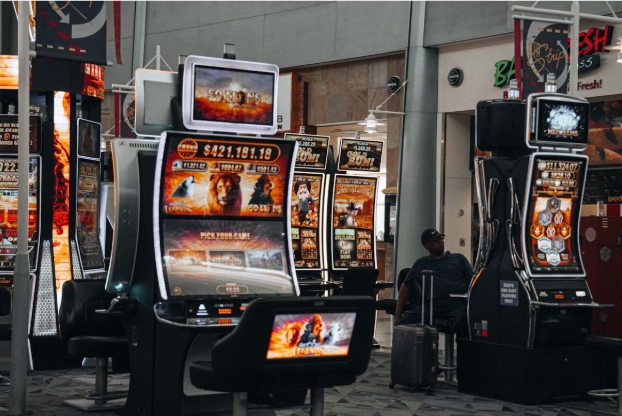Slots rake in the majority of profits for casino businesses, which is why they receive a lot of attention from game-makers. Over the past few decades, slots have undergone massive changes, while their core concept has remained intact. Players still need to align the same symbols to receive money, but paylines, stacking multipliers, unique reel mechanics, and other elements play a huge role in how things play out. In fact, you could argue that slots have become too complex, and that many casino gamers crave a more simplified gambling experience.
Even if you weld together multiple popular features, you won’t end up with a casino game that resonates well with the entire user base. We have seen a significant rise in casino mini-games and arcades that are way easier to comprehend compared to slots. You can go over the chicken road review and see how more features don’t directly translate into better game quality and better user experience. Here, all you need to do is make a decision: if you want to cash out your winnings or push the envelope and try to multiply your stake further. Even this bare-bones concept is enough for a thrilling experience. With that in mind, let’s see what makes for a good slot game and why certain titles are still performing well despite their decade-old release date.
Key Features Players Look For
Unlike other casino games, slots aren’t really compatible with different bankroll management strategies. In roulette, blackjack, and baccarat, you get to make wagers that pay 1:1, and your chance of winning those bets is nearly 50%. So you can use betting strategies like Martingale, Paroli System, or Oscar Grind. Luckily, that’s not the reason why players love slots in the first place. What makes slots so appealing is the potential jackpot or mind-bending multipliers. Even if the occurrence of these outcomes is below 1%, the potential payout easily makes up for it. To that end, one of the key features players look for is the jackpot.
There are different types of jackpots in slot games, usually called mini, super, and mega, and all of these can occur regardless of your bet size. However, the jackpot amounts are higher or lower depending on your stake. Now, there is also a so-called progressive jackpot that drops randomly, and its value is not affected by the bet size. There were recorded instances where players managed to get this prize even when they played at the lowest stake allowed.
Another type of jackpot is called a hot drop jackpot, but games with this feature are only available on a few online casinos. Still, many players love hot drop jackpots because they are guaranteed to drop within a set time frame. There are hourly and daily drops, and a so-called big drop. Now, hourly jackpots need to drop once every 60 minutes, while dailies drop once within 24 hours. The big drop doesn’t have a set time limit, but it must happen before the prize pool reaches $250,000.
Of course, there are other features that players look for, but we’ll explain those later on. Jackpot slots tend to receive more attention, especially if they are progressive jackpot slots that have a prize pool of a million or more.
Graphics, Sound, and User Interface
Although graphics, or art style, and sound effects don’t seem as important as other features, they still affect which game a player picks to play. This is especially true for those who play on Canadian sweepstakes casinos since they don’t win real money. In these conditions, elements like themes and animations matter more, since players will more likely play those slots that are inspired by IPs from pop culture. Sound effects, background music, and interface design also help make these slots more immersive and memorable.
RTP and Volatility Balance
RTP and Volatility aren’t things you notice when you start to play, but in the long run, they become more important. So, seasoned players pay attention to these characteristics when choosing a slot game.
RTP represents the percentage of money that a slot game has released as winnings to the players, and it’s measured against total money wagered on that slot. It can also be measured on a monthly or daily basis. In these instances, the RTP might even go above 100% (e.g., if only $100 were spent within the last 24 hours, and total winnings are $150). Still, many players choose to look up RTP in game reviews so that they can get info on the average RTP that was obtained through testing. This gives them a more realistic insight into what to expect.
Volatility determines how frequently you’ll get a winning combination. Lower volatility slots give more consistent wins, while high volatility slots rarely let you win, or if they do the payout is significantly lower than the bet amount. However, higher volatility games are more likely to have big jackpots or bonus rounds with big multipliers. So, even if you go hundreds of spins without meaningful wins, you can recoup lots of those losses once you enter the bonus round.
Even though RTP and Volatility don’t have a direct correlation, it’s generally safer to play lower volatility slots with high RTP. You can look at software provider reviews and then find the game you like based on volatility and measured RTP.

Bonus Rounds and Mechanics
Bonus rounds have become another iconic feature in online slots. They might be difficult to trigger, but the win rate and winning multipliers increase significantly during this round. What’s more, there’s also a bonus buy feature that allows players to buy the outcome that triggers the bonus round.
Other notable mechanics don’t really affect payouts, but they do affect how the game looks and feels:
- Cascade reels: Scoring a win removes the combined symbols and rearranges them to potentially create new winning combos
- Sticky wilds: Wild symbols stick around for subsequent spins to improve your odds of winning
- Cluster pays: Instead of traditional paylines, you form winning combos by getting the same symbols in clusters
- Megaways: A layout where you have more reels and lines, and over a thousand betways
Licensing and Fairness
Finally, players want to spend on those games that are designed in accordance with certain rules and regulations. Institutions or auditors like iTechLabs and eCOGRA extensively test new releases in order to certify them for fairness. Licensing bodies make sure that the games operate ethically, meaning they adhere to prescribed RTP standards, and they don’t include features that lead to extensive spending.


